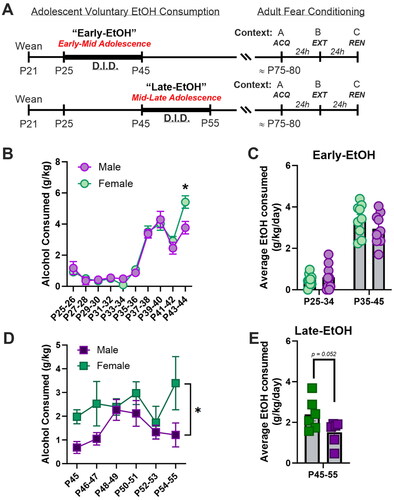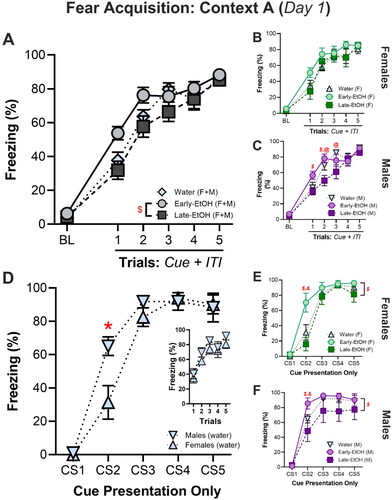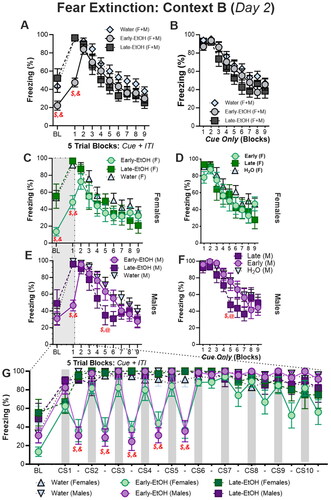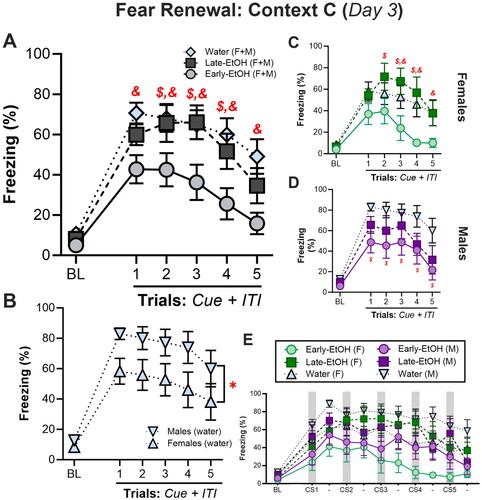Figures & data
Figure 1. A. Schematic of the study design. Rats either consumed alcohol daily on a DID schedule early (top row) or late (bottom row) in adolescence. Upon adulthood, rats were trained in a three-context (ABC) fear renewal paradigm. B-C. Consumption (g/kg/day) for rats in the Early-EtOH group for two-day averages (B) or separated by early 4/h and later 5h periods (C). D-E. Consumption of alcohol for rats in the Late-EtOH shown in either 2-day averages (D) or overall for the entire adolescent period (E). *p < 0.05, male vs female.

Figure 2. Adolescent alcohol consumption alter acquisition of fear in adulthood. A-C. Freezing during trials (10s cue + 60s ITI). A. Omnibus test of fear acquisition indicates that Early-EtOH rats freeze more, particularly during early trials, than Late-EtOh and water controls. B. Female rats (all alcohol groups) and C. male rats across fear acquisition trials. D-F. Data showing activity during the CS alone indicates emergent differences by sex. D. Comparison between male and female controls during fear acquisition. E. Female rats (all alcohol groups) and F. male rats during the CS presentations in fear acquisition. $p < 0.05, Early-EtOH vs Late-EtOH; *p < 0.05, male vs female; &p < 0.05, Early-EtOH vs Water; @p < 0.05, Late-EtOH vs Water.

Figure 3. Adolescent alcohol differentially alters fear retention, extinction, and context discrimination. A. Freezing during baseline (BL) as well as trials (10s cue + 30s ITIs) averaged into blocks of 5 trials. B. Similar to A, but showing freezing only during the cue period (i.e., without the subsequent ITI). C-D. Female rats throughout fear extinction training (5-Trial Blocks) using the cue + ITI average period (C) and the cue-only (D) periods. E-F. Male rats throughout fear extinction training (5-Trial Blocks) using the cue + ITI average period (E) and the cue-only (F) periods. G. BL (180s), CS (10s), and ITIs (30s) graphed chronologically for first 10 CS presentations of extinction reveal distinct patterns of freezing in Early-EtOH rats only during early cues but no other periods. $p < 0.05, Early-EtOH vs Late-EtOH; *p < 0.05, male vs female; &p < 0.05, Early-EtOH vs Water; @p < 0.05, Late-EtOH vs Water.

Figure 4. Adolescent alcohol impacts fear renewal in adulthood in a sex- and development-dependent manner. A. Omnibus test of freezing during fear renewal trials (10s cue + 30s ITI) in context C reveal that Early-EtOH rats show substantially less context-appropriate renewal of fear. B. Male and female controls confirm inherent sex-differences in expression of fear renewal. C. Female rats and D. male rats across fear renewal test show sex-dependent differences in freezing among Late-EtOH rats. E. Trial-by-trial analysis showing freezing during both the 10s cue (shaded bars) and 30s ITI periods for all groups and treatments. $p < 0.05, Early-EtOH vs Late-EtOH; &p < 0.05, Early-EtOH vs Water; @Late-EtOH vs Water.

